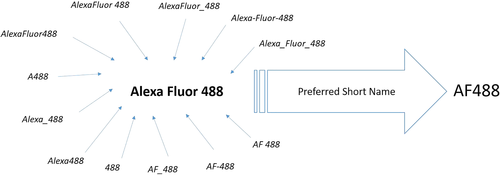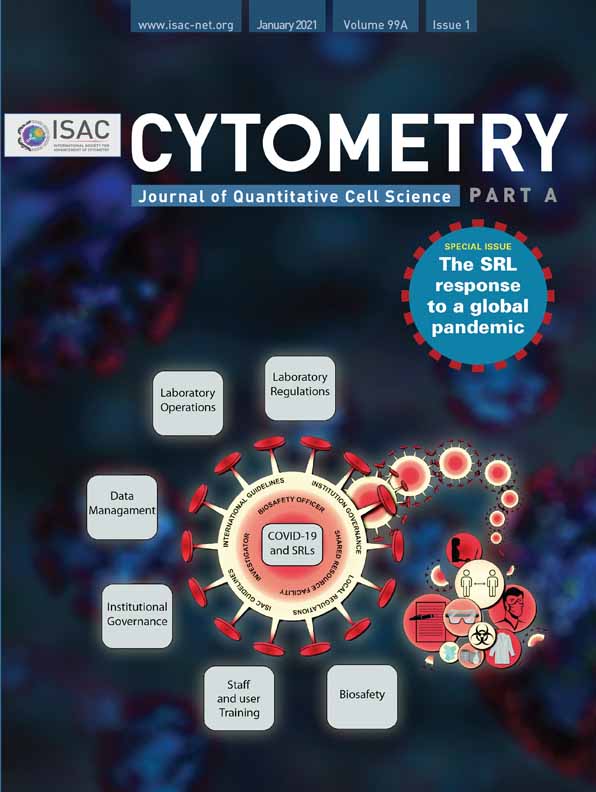ISAC Probe Tag Dictionary: Standardized Nomenclature for Detection and Visualization Labels Used in Cytometry and Microscopy Imaging
Abstract
Since the advent of microscopy imaging and flow cytometry, there has been an explosion in the number of probes, consisting of a component binding to an analyte and a detectable tag, to mark areas of interest in or on cells and tissue. Probe tags have been created to detect and/or visualize probes. Over time, these probe tags have increased in number. The expansion has resulted in arbitrarily created synonyms of probe tags used in publications and software. The synonyms are problematic for readability of publications, accuracy of text/data mining, and bridging data from multiple platforms, protocols, and databases for Big Data analysis. Development and implementation of a universal language for probe tags will ensure equivalent quality and level of data being reported or extracted for clinical/scientific evaluation as well as help connect data from many platforms. The International Society for Advancement of Cytometry Data Standards Task Force composed of academic scientists and industry hardware/software/reagent manufactures have developed recommendations for a standardized nomenclature for probe tags used in cytometry and microscopy imaging. These recommendations are shared in this technical note in the form of a Probe Tag Dictionary. © 2020 International Society for Advancement of Cytometry
Introduction
Probes (e.g., mouse anti-human CD3 Alexa Fluor 488) are used in microscopy imaging and cytometry to identify and isolate targets of interest in or on cells and tissue. Probes are composed of one or two parts. All probes have a target binder, which is a biomolecule or a chemical compound that directly binds the target of interest. In FCS 3.2 and above, the target binder is identified by keyword $PnANALYTE. Some probes have intrinsic ability to be detected and visualized natively (e.g., DAPI) without additional components. In others, labels called Tags (e.g., Alexa Fluor 488 or 141Pr) have been added to detect and/or visualize target binders that lack these intrinsic abilities. In FCS 3.2, the Tag is identified by keyword $PnTAG.
There has been an explosion in the number of analytes and tags over the last several decades (1-16). These expansions have resulted in arbitrarily created synonyms of probe tags that are evident in publications and software. The synonyms, based on the name given by the manufacturer, are generally abbreviations, variations in text formatting, or combinations of these entities. These synonyms are problematic for readability of publications and accuracy of text and data mining. They also make it difficult to bridge data from multiple platforms, protocols, and databases for Big Data analysis. To address these issues, a universal language for probe tags is required. Development and implementation of a universal language will help to ensure equivalent quality and level of data being reported or extracted for clinical and scientific evaluation. A universal language will also help to connect data from many platforms. The International Society for Advancement of Cytometry Data Standards Task Force composed of academic scientists and industry manufactures of hardware, software, and reagents have developed recommendations for a standardized nomenclature for probe tags used in cytometry and microscopy imaging (Figure 1). The standardized nomenclature is presented as the preferred short name.

Materials and Methods
The current Probe Tag Dictionary contains past and present commercially available probe tags with suggested preferred short names to be used in instances where an abbreviation is desired. The Probe Tag Dictionary will be maintained by the International Society for Advancement of Cytometry Data Standards Task Force (Tables 1–3). It will be updated at minimum annually to include new probe tags as they become available. The dictionary will contain three sections (Tables 1–3): (1) fluorochromes and Fluorescent Reagents—probe tags used in flow cytometry, imaging cytometry, solid tissue cytometry, and fluorescent microscopy (Table 1), (2) isotopes—probe tags used in mass spec cytometry of single-cell suspensions and histology tissue (Table 2), and (3) Chromogens—probe tags used primarily in brightfield solid tissue cytometry and microscopy imaging (Table 3). The commercial product names for tags used to visualize probes are listed in the Probe Tag column of the tables. The preferred short name is derived from common user synonyms and/or short message service (SMS)-style abbreviations of the product name. The SMS-style reduces the number of letters in the product name to the minimal required to recognize the product. Any required spaces within the preferred short name have been replaced with a hyphen. For fluorochromes and fluorescent reagents, excitation and emission maxima are listed (Table 1). For chromogens, the precipitate color is listed (Table 3). CAS numbers were kindly provided by the American Chemical Society. The Probe Tag Dictionary in its entirety is located at https://github.com/ISAC-DSTF/ProbeTagDictionary for users, developers, manufactures, and vendors.
| Probe taga | Preferred short nameb | Excitation maximum (nm)c | Emission maximum (nm)c | CAS numberd |
|---|---|---|---|---|
| Allophycocyanin-Cy7 | APC-Cy7 | 650 | 767 | – |
| Brilliant Utraviolet 805 | BUV805 | 348 | 805 | – |
| Cascade Blue | Cascade-Blue | 401 | 420 | 1325-87-7 |
| Cyanine 3.5 | Cy3.5 | 581 | 598 | 189767-45-1 |
| Dynomics DY-752 | DY-752 | 748 | 772 | – |
| eFluor 450 | eFluor450 | 400 | 450 | 1592653-87-6 |
| LIVE/DEAD Fixable Aqua Dead Cell Stain | LIVE/DEAD-Aqua | 367 | 526 | 1431148-98-9 |
| Pacific Blue | PacBlue | 405 | 455 | 215868-31-8 |
| Rhodamine 110 | Rho110 | 497 | 520 | 13558-31-1 |
| Vybrant DyeCycle Green | VDC-Green | 505 | 535 | 1431152-50-9 |
- a Commercial product name of the tag used to visualize probe.
- b Suggested term to be used in instances where an abbreviated form of the commercial product name is desired.
- c Maximum excitation and emission as provided by commercial manufactures.
- d Chemical Abstract Services (CAS) numbers provided by the American Chemical Society.
| Probe taga | Preferred short nameb |
|---|---|
| 141 Praseodymium | 141Pr |
| 142 Neodymium | 142Nd |
| 147 Samarium | 147Sm |
| 151 Europium | 151Eu |
| 155 Gadolinium | 155Gd |
| 159 Terbium | 159 Tb |
| 161 Dysprosium | 161Dy |
| 165 Holmium | 165Ho |
| 166 Erbium | 166Er |
| 169 Thulium | 169Tm |
| 171 Ytterbium | 171Yb |
- a Commercial product name of the label used to visualize probes.
- b Suggested term to be used in instances where an abbreviated form of the commercial product name is desired.
| Probe taga | Preferred short nameb | Precipitate colorc |
|---|---|---|
| 3,3′-Diaminobenzidine | DAB | Brown |
| 3-amino-9-ethylcarbazole | AEC | Red |
| Permanent Red | PermRed | Magenta |
| Discovery Purple | DiscPurple | Purple |
| VECTOR Blue | vctrBlue | Blue |
| Fast Red | FastRed | Magenta |
| Fast Blue | FastBlue | Blue |
| Deep Space Black | DS-Black | Black |
- a Commercial product name of the tag used to visualize probes.
- b Suggested term to be used in instances where an abbreviated form of the commercial product name is desired.
- c Color of the precipitate formed as a result of the enzymatic reaction of the chromogen with horseradish peroxidase or alkaline phosphates.
Results
Table 1 is a small excerpt of Section 1 of the Probe Tag Dictionary listing fluorochromes and fluorescent reagent probe tags and their corresponding preferred short names.
Table 2 is a small excerpt of Section 2 of the Probe Tag Dictionary listing isotope probe tags and their corresponding preferred short names.
Table 3 is a small excerpt of Section 3 of the Probe Tag Dictionary listing chromogen probe tags and their corresponding preferred short names.
Discussion
The purpose of the Probe Tag Dictionary is to provide a single preferred short name that can be used as an abbreviation of a specific commercial probe tag. The preferred short name is designed to be functionally useful for both technology users and software developers. It is recommended that it be used in instances where abbreviations of probe tags are presented in publications with respect to listings in keywords, body of manuscripts, tables, and figures (including axis and legends). Using the preferred short name in this context will promote a peer-reviewed publication environment that is built on standardization. This will lead to better reproducibility of data and improve the ability to merge and compare different datasets. The preferred short name is also recommended to be used as an easily recognizable standardized common name for pull down menus and as the universal language in coding in general for software used in imaging and cytometry platforms. This standardization is incorporated in FCS3.2. Incorporation of a new probe tag to the Probe Tag Dictionary can be requested through https://github.com/ISAC-DSTF/ProbeTagDictionary.
In conclusion, we publish this Probe Tag Dictionary with the goal of helping the medical and scientific community to facilitate the use of probe information in Big Data. We anticipate that adoption of the preferred short names will significantly increase the quality and interoperability of data in Big Data multiplatform datasets.
Ethics Statement
No humans or animals were used in this published work. Therefore, no human or animal ethics review committees were required.
In Memoriam
In memory of Robert C. Leif, PhD, PMIAC, February 27, 1938 to August 3, 2020, a pioneer and lifetime contributor to the field of cytometry.
Acknowledgments
The authors would like to thank the American Chemical Society for graciously providing CAS numbers. The authors would also like to thank all members of the ISAC Data Standards Task Force for their insight and contributions to the submitted work.
Author Contributions
Kim Blenman: Conceptualization; data curation; methodology; project administration; supervision; validation; writing-original draft; writing-review and editing. Josef Spidlen: Writing-review and editing. David Parks: Writing-review and editing. Wayne Moore: Writing-review and editing. Adam Treister: Conceptualization; writing-review and editing. Robert Leif: Writing-review and editing. Chris Bray: Writing-review and editing. Michael Goldberg: Writing-review and editing. Ryan Brinkman: Conceptualization; writing-review and editing.
Conflicts of Interest
Members of ISAC Data Standards Task Force include representatives of companies selling flow cytometry instrumentation, software, and reagents.




